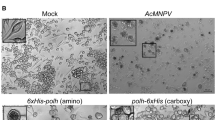Abstract
Three proteins, namely, the core protein C and envelope glycoproteins E1 and E2, are main structural proteins forming a hepatitis C virus (HCV) virion. The virus structure and assembly and the role of the structural proteins in virion morphogenesis remain unknown because of the lack of an efficient culture system for HCV to be grown in vitro. Highly efficient heterologous expression systems make it possible to obtain self-assembled, nonreplicating, genome-lacking particles that are morphologically similar to intact virions. Using recombinant baculoviruses expressing the HCV structural protein genes in insect cells, the individual HCV structural proteins were expressed to 25–35% of the total cell protein, and the CE1 and E1E2 heterodimers and HCV-like particles were obtained. It was demonstrated that the recombinant C, E1, and E2 proteins underwent posttranslational modification, the glycoproteins formed a noncovalent heterodimer, and HCV- like particles were located in endoplasmic reticulum membranes of infected cells. The formation of E1E2 dimers and HCV-like particles was used to study the effect of E1 glycosylation on the expression and processing of the coat proteins.
Similar content being viewed by others
References
Hoofnagle J.H. 2002. Course and outcome of hepatitis C. Hepatology. 35, 21–29.
Pawlotsky, J.M. 2003. Hepatitis C virus genetic variability: Pathogenic and clinical implications. Clin. Liver Dis. 7, 45–66.
Vauloup-Fellous C., Pene V., Garaud-Aunis J., Harper F., Bardin S., Suire Y., Pichard E., Schmitt A., Sogni P., Pierron G., Briand P., Rosenberg A.R. 2006. Signal peptide peptidase-catalyzed cleavage of hepatitis C virus core protein is dispensable for virus budding but destabilizes the viral capsid. J. Biol. Chemistry. 281, 27679–27692.
Dubuisson J. and Rice C.M. 1996. Hepatitis C virus glycoprotein folding: Disulfide bond formation and association with calnexin. J. Virology. 70, 778–786.
Lin C., Lindenbach B.D., Pragai B., McCourt D.W., Rice C.M. 1994. Processing of the hepatitis C E2-NS2 region: Identification of the p7 and two distinct E2-specific products with different C termini. J. Virol. 68, 5063–5073.
Yasui K., Wakita T., Tsukiyama-Kohara K., Funahashi S.I., Ichikawa M., Kajita T., Moradpour D., Wands J.R., Kohara M. 1998. The native form and maturation process of the hepatitis C virus core protein. J. Virol. 72, 6048–6055.
Liu Q., Tackney C., Bhat R.A., Prince A.M., Zhang P. 1997. Regulated processing of the hepatitis C virus core protein is linked to subcellular localization. J. Virol. 71, 657–662.
Matsumoto M., Hwang S.B., Jeng K.S., Zhu N., Lai M.M. 1996. Homotypic interaction and multimerization of hepatitis C virus core protein. Virology. 218, 43–51.
Choo Q.L., Kuo G., Weiner A. J., Overby L.R., Bradley D.W., Houghton M. 1989. Isolation of a cDNA clone derived from blood-borne non-A, non-B viral hepatitis genome. Science. 244, 359–362.
Crawford S.E., Labbé M., Cohen J., Burroughs M.H., Zhou Y.J., Estes M.K. 1994. Characterization of virus-like particles produced by the expression of rotavirus capsid proteins in insect cells. J. Virol. 68, 5945–5952.
Li T.C., Takeda N., Kato K., Nilsson J., Xing L., Haag L., Cheng R.H., Miyamura T. 2003. Characterization of self-assembled virus-like particles of human polyomavirus BK generated by recombinant baculoviruses. Virology. 311, 115–124.
Cruz P.E., Maranga L., Carrondo M.J. 2002. Integrated process optimization: lessons from retrovirus and virus-like particle production. J. Biotechnol. 99, 199–214.
Baumert T.F., Ito S., Wong D.T., Liang T.J. 1998. Hepatitis C virus structural proteins assemble into virus-like particles in insect cells. J. Virol. 72, 3827–3836.
Reed K.E., Rice C.M. 2000. Overview of hepatitis C virus genome structure, polyprotein processing, and protein properties. Curr. Top. Microbiol. Immunol. 242, 55–84.
Belzhelarskaya S.N. 2002. Baculoviral expression system in insect cells. Mol. Biol. 36, 371–385.
Maniatis T., Fritsch E.F., Sambrook J. 1982. Molecular Cloning: A Laboratory Manual. Cold Spring Harbor, NY: Cold Spring Harbor Lab. Press.
Bac-to-Bac Baculovirus Expression System. Instruction Manual. St. Louis, MO: Life Technologies, Inc., Monsanto Corp. Res., 1993.
Mokhonov V.V., Novikov D.V., Samokhvalov E.I., Shatalov A.G., Selivanov N.A., Prilipov A.G., ’ D.K. 2002. Genome analysis of Hepatitis C virus strain 274933RU isolated in Russian Federation. Vopr. Virusol. 47, 9–12.
King L.A., Possee R.D. 1992. The Baculovirus Expression System: A Laboratory Guide. London: Chapman and Hall.
Drutsa I.L., Kaberdin V.R., Koroleva O.N., Shilov I.O. 1991. Effective method for directed introduction of mutations into plasmids and cloning of single-stranded DNA fragments. Bioorg. Khimiya. 17, 1487–1493.
Choi S.H., Kim S.Y., Park K.J., Kim Y.J., Hwang S.B. 2004. Hepatitis C virus core protein is efficiently released into the culture medium in insect cells. J. Biochem. Mol. Biol. 37, 735–740.
Zhao W., Liao G.Y., Jiang Y.J., Jiang S.D. 2003. No requirement of HCV 5’NCR for HCV-like particles assembly in insect cells. J. Gastroenterol. 10, 2226–2231.
Goffard A., Callens N., Bartosch B., Wychowski C., Cosset F.L., Montpellier C., Dubuisson J. 2005. Role of N-linked glycans in the functions of hepatitis C virus envelope glycoproteins. J. Virol. 79, 8400–8409.
Ivanov A.V., Kuzyakin A.O., Kochetkov S.N. 2005. Moleular biology of hepatitis C virus. Usp. Biokhim. 45, 37–86.
Duvet S., Op de Beek A., Cocquerel L., Wychowski C., Cacan R., Dubuisson J. 2002. Glycosylation of the hepatitis C virus envelope protein E1 occurs posttranslationally in a mannosylphosphoryldolichol-deficient CHO mutant cell line. Glycobiology. 12(2), 95–101.
Author information
Authors and Affiliations
Corresponding author
Additional information
Original Russian Text © S.N. Belzhelarskaya, N.N. Koroleva, V.V. Popenko, V.L. Drutza, O.V. Orlova, P.M. Rubtzov, S.N. Kochetkov, 2010, published in Molekulyarnaya Biologiya, 2010, Vol. 44, No. 1, pp. 107–119.
Rights and permissions
About this article
Cite this article
Belzhelarskaya, S.N., Koroleva, N.N., Popenko, V.V. et al. Hepatitis C virus structural proteins and virus-like particles produced in recombinant baculovirus-infected insect cells. Mol Biol 44, 97–108 (2010). https://doi.org/10.1134/S0026893310010139
Received:
Accepted:
Published:
Issue Date:
DOI: https://doi.org/10.1134/S0026893310010139




